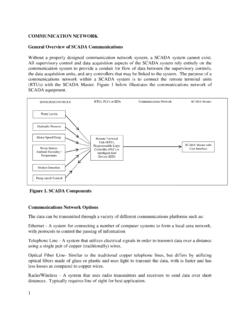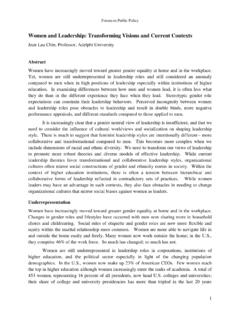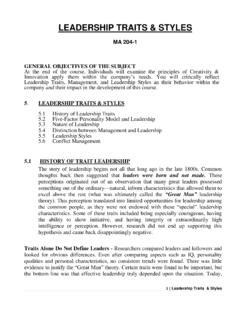Transcription of Gender Styles in Communication - University of Kentucky
1 Gender Styles in CommunicationDebra GrahamUniversity of KentuckyHuman Resources Training and DevelopmentInterpersonal Communication -Organizations are made up of people from different backgrounds, cultures, Gender , behavior, personalities and perceptions who have to work together to achieve a common organizational goal. Inevitably these people have to communicate on a personal basis and share ideas, so as to move in the same Do You Believe?Men talk more than Despite the stereotype, whether in classrooms, offices, group discussion or in two-person conversations, men talk more than their fair share of the time. For example, in one experiment, male and female subjects were asked to verbally describe pictures and engravings. The women s average description was approximately three minutes.
2 For a man, the average time was 13 Do You Believe?Men are more likely to interrupt women than to interrupt other women talk with other women, interruptions are evenly distributed. When men talk with other men, interruptions are evenly distributed. However when men and women talk with one another, almost all of the interruptions are by male Do You Believe?During conversations, women spend more time looking at their partners than men studies have shown that women are more likely than men to look at their partner, One reason may be that men talk more and women listen more. Another possible reason may be the need for and expertise in decoding nonverbal cures. In a direct staring confrontation, women will be more likely to avert their eyes, especially when stared at by Do You Believe?
3 Men not only control the content of conversations, they also work harder in keeping conversations men do exert power and authority in controlling the course of conversations, women exert more effort in maintaining Do You Believe?When people hear generic words, such as mankind and he, they respond such as mankind and he are supposed to be generic and are presumed to include both men and women. Research shows that people are more literal in their Do You Believe?Women use less personal space than s space is far more likely to be intruded upon by others. Women are approached more closely than men by both women and men. When women and men approach each other on the street, women are more likely to walk around men or move out of their way. In homes, men are more likely to have an untouchable Do You Believe?
4 Women are more likely to answer questions that are not addressed to manage to capture more than their fair share of talk time. Sometimes, women actually help men gain this advantage because they are more likely to ask questions, while men are more likely to give Do You Believe?Female manager s are seen by both male and female subordinates as better communicators than male managers are seen as giving more attention to subordinates, as more open to new ideas, and as more supportive of worker effort than male Do You Believe?In general, men smile more often than are far more likely to smile than men. They do this in many different social situations even though they are not necessarily happy or amused. In one study, researchers smiled at approximately 150 males and 150 females in publics.
5 Women returned the smiles 93 percent of the time to men and 83 percent of the time to women. Males smiled back at women 67 percent of the time, and they returned smiles to men 58 percent of the Do You Believe?Female speakers are more animated in their style than are speakers display more animated behavior, including amount and intensity of eye contact, gestures, facial expressions, and body movement. Further, they are more likely to use a wider range of pitch and tonal variations. However, men appear to be more dramatic verbally and more likely to tell anecdotes and Interpersonal Communication Matters A Measurable impact on psychological and physical health. People with higher levels of interpersonal Communication skills are better able to adapt to; stress, have greater satisfaction in relationships and more friends, and have less depression and anxiety.
6 Meeting Basic Needs: Interpersonal Communication meets our basic needs as humans for security in our social bonds, health, and careers. Interpersonal Communication is strategic: We intentionally create messages to achieve certain goals that help us function in society and our relationships. To achieve instrumental goals such as gaining compliance: get things done in their relationships and in different aspects. The Payoff Relationship Building Customer Service Management -Imprecise and rash business Communication frequently results in wasted time Training Conflict Resolution -Interpersonal Communication is a key component of conflict management in organizationsSEX AND Gender Sex biological and physiological characteristics that define men and women Gender socially constructed roles that a given society considers appropriate for men and womenGENDER Refers to the socially constructed roles, behaviors, activities, and attributes that a given society considers appropriate for men and women.
7 "Male" and "female" are sex categories, while "masculine" and "feminine" are Gender and Female StereotypesVerbal Communication differences based on GenderMEN (Masculine) Avoid Personal stories Attempt to dominate the conversation Less likely to listen More aggressive, more prone to interruptWOMEN (Feminine) Share Personal stories Offer Personal stories Concerned with equalized input Form groups Listen Carefully / Attentively Allow themselves to be interrupted moreNon-Verbal Communication differences based on GenderBodylanguageMenWomenFacial expressionLessMoreEye contactAvoidPreferPostureMorerelaxedMore tenseBodilyproximityLessCloserTouchingSe xualinterestWarmthand friendshipMale-Female-- Communication CharacteristicsApproach with Caution! These are generalities. Your experience may be quite focus on power / rank / s tatus.
8 Women focus on relationships. Men talk to give information or talk to collect information or gain rapport. Men talk about things (bus ines s , s ports , food). Women talk about people / relationships. Men focus on facts , reas on and logic. Women focus on feelings, senses and meaning. Men thrive on competing and achieving. Women thrive on harmony and relating. Men "know" by analyzing and figuring "know" by intuiting. Men are more are more cooperative. Men tend to be focus ed, s pecific, logical. Women are holistic and organic. Men are at eas e with order, rules and s tructure. W o me n with fluid ity. Men immediately want to get working on a project. Women tend to ask lots of questions before beginning a project. Men want to think. Women want to feelBalancing Your Approach to Effective Communication Understand the motivationbehind the behavior Recognize your own Communication style and bias Be respectful and open to the other person s Communication style and values Work on compromise to bring out the strengths of the Communication styleMasculine Reminder I need to remind myself that many women may not do power like men do.
9 Women often feel oppressed by how men do power. If I interrupted less, there could be deeper Communication . I needto ask my partner for input and wait for an answer, not assuming that she will interrupt. Listeningcan be a nice way of getting to know someone, rather than helping them problem Reminders Helpfulto avoid sarcasm with women Helpfulto offer supportive feedback frequently Helpfulto be authentic and willing to occasionally share personal informationFeminine Reminders The masculine may see asking for input indirectly as submitting and wimpy thus showing a lack of confidence. You do not have to change what you are doing, just be aware of the assumptions he could be making. Remindmasculine to listen rather than fix Helpfulto remember that healthy assertion of authority is necessary with some peopleFeminine Reminders Helpfulto say to men, Please don t interrupt me.
10 Helpfulto notlet men interrupt you Helpfulto jump in early and make suggestions when talking with men, if you want to be seen as an equal Helpfulto remember that not sharing personal information is the norm for most men and not something personally directed toward you Likewise, many men don t understand why you are share so much personal informationMasculine and Feminine For either masculine or feminine: Ask Do you want me to listen or give you advice? For either masculine of feminine:When you disagree, check out the meaning of the word you are using to see if you mean the same thing. For either masculine or feminine: Ask Are you gathering input and making the final decision or are you seeking consensus? When you have just had a miscommunication, try this: I m not sure I understood what you just said.














